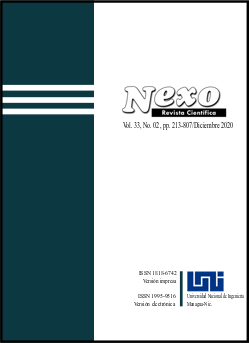Estimación de impactos de incidentes en el tiempo de viaje en la calle urbana en el caso de super saturación en las luces de traffic
DOI:
https://doi.org/10.5377/nexo.v33i02.10770Palabras clave:
Impacto, Urbano, Tiempo de viaje, Tráfico, SemáforoResumen
Las estrategias de control dinámico de la señal son efectivas para aliviar las congestiones durante los días no típicos, como aquellos con altas demandas, incidentes con diferentes atributos y condiciones climáticas adversas. Esta investigación reconoce la necesidad de modelar los impactos de los controles de señales dinámicas para diferentes días que representan diferentes niveles de demanda e incidentes. Los métodos se identifican para calibrar las herramientas utilizadas para los patrones durante diferentes días en función de las demandas y las condiciones del incidente utilizando combinaciones de datos del mundo real con diferentes niveles de detalles. Un desafío importante abordado en este estudio es garantizar que los modelos de asignación dinámica de tráfico (DTA) basados en simulación mesoscópica produzcan volúmenes de movimiento de giro en intersecciones señalizadas con suficiente precisión para el propósito del análisis. Se desarrolla un nuevo modelo para estimar la caída de la capacidad en la ubicación del incidente considerando los efectos de derrame de la cola de control de señal aguas abajo. Los modelos de reducción de capacidad desarrollados se utilizaron para estimar el retraso debido a un incidente en una calle urbana. El retraso se calculó como una combinación del retraso debido a las colas en el enlace incidente y el aumento de los retrasos en el control de la intersección aguas arriba debido a la reducción en los rendimientos máximos resultantes del derrame de la cola a la intersección aguas arriba El método basado en HCS estimó una reducción en el retraso resultante del nuevo plan de temporización de la señal será de alrededor de 3.404 horas de vehículo, mientras que el VISSIM muestra que el nuevo ahorro de temporización de la señal con retraso es de 4.008 horas de vehículo. Esto confirma que el método desarrollado y la estimación VISSIM de los beneficios son consistentes.
Descargas
Descargas
Publicado
Cómo citar
Número
Sección
Licencia
Derechos de autor 2021 Universidad Nacional de Ingeniería

Esta obra está bajo una licencia internacional Creative Commons Atribución 4.0.
Los autores que publican en Nexo Revista Científica están de acuerdo con los siguientes términos:
- Los autores conservan los derechos de autor y conceden a la revista el derecho de la primera publicación bajo la licencia Creative Commons Attribution License https://creativecommons.org/licenses/by/3.0/, que permite a otros compartir el trabajo con un reconocimiento a la autoría de la obra y a la publicación inicial en Nexo Revista Científica.
- Los autores pueden establecer por separado acuerdos adicionales para la distribución no exclusiva de la versión de la obra publicada en la revista (por ejemplo, en un repositorio institucional o en un libro) con el reconocimiento de su publicación inicial en Nexo Revista Científica.
- Se permite y se anima a los autores a difundir sus trabajos electrónicamente (por ejemplo, en repositorios institucionales o en su propio sitio web) antes y durante el proceso de envío, ya que puede dar lugar a intercambios productivos, así como a una citación más temprana y mayor de los trabajos publicados.











